Kangfei Zhao
A Survey of Graph Transformers: Architectures, Theories and Applications
Feb 23, 2025



Abstract:Graph Transformers (GTs) have demonstrated a strong capability in modeling graph structures by addressing the intrinsic limitations of graph neural networks (GNNs), such as over-smoothing and over-squashing. Recent studies have proposed diverse architectures, enhanced explainability, and practical applications for Graph Transformers. In light of these rapid developments, we conduct a comprehensive review of Graph Transformers, covering aspects such as their architectures, theoretical foundations, and applications within this survey. We categorize the architecture of Graph Transformers according to their strategies for processing structural information, including graph tokenization, positional encoding, structure-aware attention and model ensemble. Furthermore, from the theoretical perspective, we examine the expressivity of Graph Transformers in various discussed architectures and contrast them with other advanced graph learning algorithms to discover the connections. Furthermore, we provide a summary of the practical applications where Graph Transformers have been utilized, such as molecule, protein, language, vision traffic, brain and material data. At the end of this survey, we will discuss the current challenges and prospective directions in Graph Transformers for potential future research.
ScaDyG:A New Paradigm for Large-scale Dynamic Graph Learning
Jan 27, 2025Abstract:Dynamic graphs (DGs), which capture time-evolving relationships between graph entities, have widespread real-world applications. To efficiently encode DGs for downstream tasks, most dynamic graph neural networks follow the traditional message-passing mechanism and extend it with time-based techniques. Despite their effectiveness, the growth of historical interactions introduces significant scalability issues, particularly in industry scenarios. To address this limitation, we propose ScaDyG, with the core idea of designing a time-aware scalable learning paradigm as follows: 1) Time-aware Topology Reformulation: ScaDyG first segments historical interactions into time steps (intra and inter) based on dynamic modeling, enabling weight-free and time-aware graph propagation within pre-processing. 2) Dynamic Temporal Encoding: To further achieve fine-grained graph propagation within time steps, ScaDyG integrates temporal encoding through a combination of exponential functions in a scalable manner. 3) Hypernetwork-driven Message Aggregation: After obtaining the propagated features (i.e., messages), ScaDyG utilizes hypernetwork to analyze historical dependencies, implementing node-wise representation by an adaptive temporal fusion. Extensive experiments on 12 datasets demonstrate that ScaDyG performs comparably well or even outperforms other SOTA methods in both node and link-level downstream tasks, with fewer learnable parameters and higher efficiency.
Natural Language-Assisted Multi-modal Medication Recommendation
Jan 13, 2025Abstract:Combinatorial medication recommendation(CMR) is a fundamental task of healthcare, which offers opportunities for clinical physicians to provide more precise prescriptions for patients with intricate health conditions, particularly in the scenarios of long-term medical care. Previous research efforts have sought to extract meaningful information from electronic health records (EHRs) to facilitate combinatorial medication recommendations. Existing learning-based approaches further consider the chemical structures of medications, but ignore the textual medication descriptions in which the functionalities are clearly described. Furthermore, the textual knowledge derived from the EHRs of patients remains largely underutilized. To address these issues, we introduce the Natural Language-Assisted Multi-modal Medication Recommendation(NLA-MMR), a multi-modal alignment framework designed to learn knowledge from the patient view and medication view jointly. Specifically, NLA-MMR formulates CMR as an alignment problem from patient and medication modalities. In this vein, we employ pretrained language models(PLMs) to extract in-domain knowledge regarding patients and medications, serving as the foundational representation for both modalities. In the medication modality, we exploit both chemical structures and textual descriptions to create medication representations. In the patient modality, we generate the patient representations based on textual descriptions of diagnosis, procedure, and symptom. Extensive experiments conducted on three publicly accessible datasets demonstrate that NLA-MMR achieves new state-of-the-art performance, with a notable average improvement of 4.72% in Jaccard score. Our source code is publicly available on https://github.com/jtan1102/NLA-MMR_CIKM_2024.
* 10 pages
CardOOD: Robust Query-driven Cardinality Estimation under Out-of-Distribution
Dec 08, 2024Abstract:Query-driven learned estimators are accurate, flexible, and lightweight alternatives to traditional estimators in query optimization. However, existing query-driven approaches struggle with the Out-of-distribution (OOD) problem, where the test workload distribution differs from the training workload, leading to performancedegradation. In this paper, we present CardOOD, a general learning framework designed to construct robust query-driven cardinality estimators that are resilient against the OOD problem. Our framework focuses on offline training algorithms that develop one-off models from a static workload, suitable for model initialization and periodic retraining. In CardOOD, we extend classical transfer/robust learning techniques to train query-driven cardinalityestimators, and the algorithms fall into three categories: representation learning, data manipulation, and new learning strategies. As these learning techniques are originally evaluated in computervision tasks, we also propose a new learning algorithm that exploits the property of cardinality estimation. This algorithm, lying in the category of new learning strategy, models the partial order constraint of cardinalities by a self-supervised learning task. Comprehensive experimental studies demonstrate the efficacy of the algorithms of CardOOD in mitigating the OOD problem to varying extents. We further integrate CardOOD into PostgreSQL, showcasing its practical utility in query optimization.
All-in-One: Heterogeneous Interaction Modeling for Cold-Start Rating Prediction
Mar 28, 2024



Abstract:Cold-start rating prediction is a fundamental problem in recommender systems that has been extensively studied. Many methods have been proposed that exploit explicit relations among existing data, such as collaborative filtering, social recommendations and heterogeneous information network, to alleviate the data insufficiency issue for cold-start users and items. However, the explicit relations constructed based on data between different roles may be unreliable and irrelevant, which limits the performance ceiling of the specific recommendation task. Motivated by this, in this paper, we propose a flexible framework dubbed heterogeneous interaction rating network (HIRE). HIRE dose not solely rely on the pre-defined interaction pattern or the manually constructed heterogeneous information network. Instead, we devise a Heterogeneous Interaction Module (HIM) to jointly model the heterogeneous interactions and directly infer the important interactions via the observed data. In the experiments, we evaluate our model under three cold-start settings on three real-world datasets. The experimental results show that HIRE outperforms other baselines by a large margin. Furthermore, we visualize the inferred interactions of HIRE to confirm the contribution of our model.
A Fused Gromov-Wasserstein Framework for Unsupervised Knowledge Graph Entity Alignment
May 11, 2023Abstract:Entity alignment is the task of identifying corresponding entities across different knowledge graphs (KGs). Although recent embedding-based entity alignment methods have shown significant advancements, they still struggle to fully utilize KG structural information. In this paper, we introduce FGWEA, an unsupervised entity alignment framework that leverages the Fused Gromov-Wasserstein (FGW) distance, allowing for a comprehensive comparison of entity semantics and KG structures within a joint optimization framework. To address the computational challenges associated with optimizing FGW, we devise a three-stage progressive optimization algorithm. It starts with a basic semantic embedding matching, proceeds to approximate cross-KG structural and relational similarity matching based on iterative updates of high-confidence entity links, and ultimately culminates in a global structural comparison between KGs. We perform extensive experiments on four entity alignment datasets covering 14 distinct KGs across five languages. Without any supervision or hyper-parameter tuning, FGWEA surpasses 21 competitive baselines, including cutting-edge supervised entity alignment methods. Our code is available at https://github.com/squareRoot3/FusedGW-Entity-Alignment.
Robust Attributed Graph Alignment via Joint Structure Learning and Optimal Transport
Jan 30, 2023



Abstract:Graph alignment, which aims at identifying corresponding entities across multiple networks, has been widely applied in various domains. As the graphs to be aligned are usually constructed from different sources, the inconsistency issues of structures and features between two graphs are ubiquitous in real-world applications. Most existing methods follow the ``embed-then-cross-compare'' paradigm, which computes node embeddings in each graph and then processes node correspondences based on cross-graph embedding comparison. However, we find these methods are unstable and sub-optimal when structure or feature inconsistency appears. To this end, we propose SLOTAlign, an unsupervised graph alignment framework that jointly performs Structure Learning and Optimal Transport Alignment. We convert graph alignment to an optimal transport problem between two intra-graph matrices without the requirement of cross-graph comparison. We further incorporate multi-view structure learning to enhance graph representation power and reduce the effect of structure and feature inconsistency inherited across graphs. Moreover, an alternating scheme based algorithm has been developed to address the joint optimization problem in SLOTAlign, and the provable convergence result is also established. Finally, we conduct extensive experiments on six unsupervised graph alignment datasets and the DBP15K knowledge graph (KG) alignment benchmark dataset. The proposed SLOTAlign shows superior performance and strongest robustness over seven unsupervised graph alignment methods and five specialized KG alignment methods.
Predicting Protein-Ligand Binding Affinity with Equivariant Line Graph Network
Oct 27, 2022



Abstract:Binding affinity prediction of three-dimensional (3D) protein ligand complexes is critical for drug repositioning and virtual drug screening. Existing approaches transform a 3D protein-ligand complex to a two-dimensional (2D) graph, and then use graph neural networks (GNNs) to predict its binding affinity. However, the node and edge features of the 2D graph are extracted based on invariant local coordinate systems of the 3D complex. As a result, the method can not fully learn the global information of the complex, such as, the physical symmetry and the topological information of bonds. To address these issues, we propose a novel Equivariant Line Graph Network (ELGN) for affinity prediction of 3D protein ligand complexes. The proposed ELGN firstly adds a super node to the 3D complex, and then builds a line graph based on the 3D complex. After that, ELGN uses a new E(3)-equivariant network layer to pass the messages between nodes and edges based on the global coordinate system of the 3D complex. Experimental results on two real datasets demonstrate the effectiveness of ELGN over several state-of-the-art baselines.
Transformer for Graphs: An Overview from Architecture Perspective
Feb 17, 2022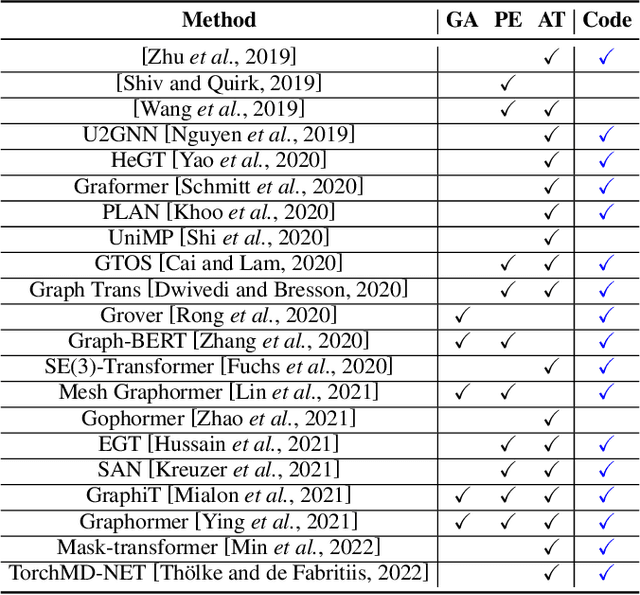
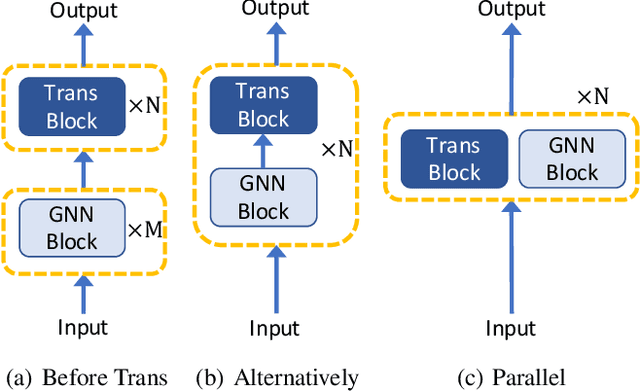
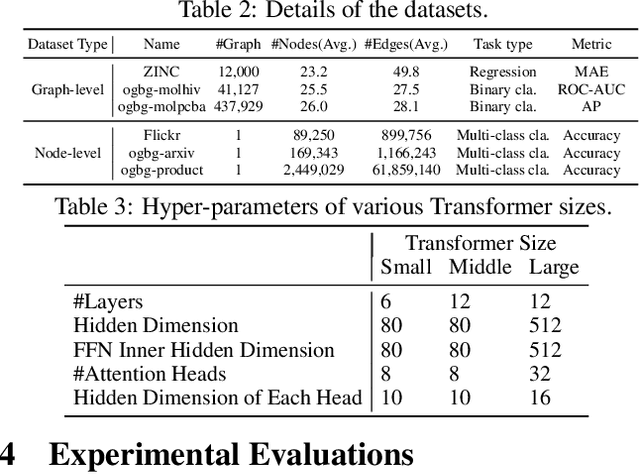
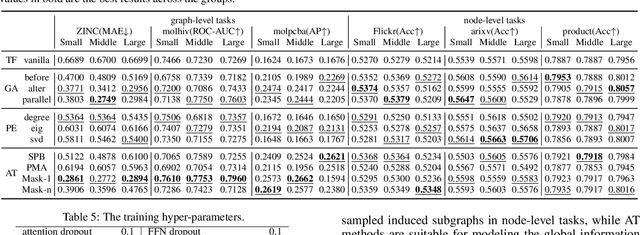
Abstract:Recently, Transformer model, which has achieved great success in many artificial intelligence fields, has demonstrated its great potential in modeling graph-structured data. Till now, a great variety of Transformers has been proposed to adapt to the graph-structured data. However, a comprehensive literature review and systematical evaluation of these Transformer variants for graphs are still unavailable. It's imperative to sort out the existing Transformer models for graphs and systematically investigate their effectiveness on various graph tasks. In this survey, we provide a comprehensive review of various Graph Transformer models from the architectural design perspective. We first disassemble the existing models and conclude three typical ways to incorporate the graph information into the vanilla Transformer: 1) GNNs as Auxiliary Modules, 2) Improved Positional Embedding from Graphs, and 3) Improved Attention Matrix from Graphs. Furthermore, we implement the representative components in three groups and conduct a comprehensive comparison on various kinds of famous graph data benchmarks to investigate the real performance gain of each component. Our experiments confirm the benefits of current graph-specific modules on Transformer and reveal their advantages on different kinds of graph tasks.
QD-GCN: Query-Driven Graph Convolutional Networks for Attributed Community Search
Apr 08, 2021


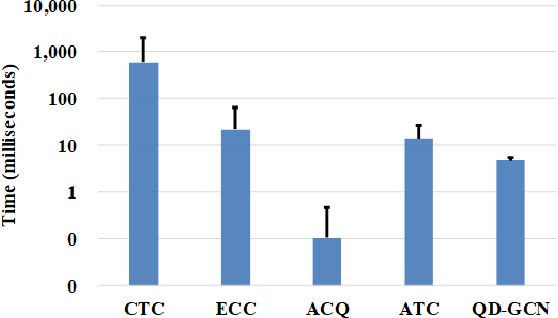
Abstract:Recently, attributed community search, a related but different problem to community detection and graph clustering, has been widely studied in the literature. Compared with the community detection that finds all existing static communities from a graph, the attributed community search (ACS) is more challenging since it aims to find dynamic communities with both cohesive structures and homogeneous node attributes given arbitrary queries. To solve the ACS problem, the most popular paradigm is to simplify the problem as two sub-problems, that is, structural matching and attribute filtering and deal with them separately. However, in real-world graphs, the community structure and the node attributes are actually correlated to each other. In this vein, current studies cannot capture these correlations which are vital for the ACS problem. In this paper, we propose Query-Driven Graph Convolutional Networks (QD-GCN), an end-to-end framework that unifies the community structure as well as node attribute to solve the ACS problem. In particular, QD-GCN leverages the Graph Convolutional Networks, which is a powerful tool to encode the graph topology and node attributes concurrently, as the backbones to extract the query-dependent community information from the original graph. By utilizing this query-dependent community information, QD-GCN is able to predict the target community given any queries. Experiments on real-world graphs with ground-truth communities demonstrate that QD-GCN outperforms existing attributed community search algorithms in terms of both efficiency and effectiveness.
 Add to Chrome
Add to Chrome Add to Firefox
Add to Firefox Add to Edge
Add to Edge